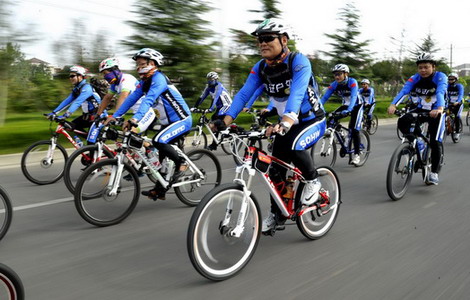

In many countries, public debate about gender equality focuses mainly on women's access to top positions and high-powered career opportunities. But the "glass ceiling" is only a small part of the issue. The broader question is whether women have the same opportunities as men to participate in labor markets in the first place. In other words, are women empowered to contribute fully to global economic growth and prosperity?
Unfortunately, the International Monetary Fund's latest study, Women, Work, and the Economy, shows that, despite some improvements, progress toward leveling the playing field for women has stalled. This is bad news for everyone, because it translates into lower economic growth - amounting to as much as 27 percent of per capita GDP in some countries.
Around the world, the number of women in the workforce remains far below that of men; only about half of working-age women are employed. Women account for most unpaid work, and, when they are paid, they are overrepresented in the informal sector and among the poor. They continue to be paid less than men for the same jobs, even in OECD countries, where the average gender wage gap is about 16 percent. And in many countries, distortions and discrimination in the labor market restrict women's chances of equal pay and rising to senior positions.
The potential gains from a larger female workforce are striking. In Egypt, for example, if the number of female workers were raised to the same level as that of men, the country's GDP could grow by 34 percent. In the United Arab Emirates, GDP would expand by 12 percent, in Japan by 9 percent, and in the United States by 5 percent. According to a recent study based on data from the International Labor Organization, of the 865 million women worldwide who could contribute more fully to their economies, 812 million live in emerging and developing countries.
Raising women's labor-market participation rate boosts economic performance in a number of ways. For example, higher incomes for women lead to higher household spending on educating girls - a key prerequisite for faster long-term growth. Employment of women on an equal basis with men provides companies with a larger talent pool, potentially increasing creativity, innovation, and productivity. And, in advanced countries, a larger female labor force can help to counteract the impact of a shrinking workforce and mitigate the costs of an aging population.
So what underlies the persistence of gaping inequality and stalled progress? Legal, regulatory, and social discrimination against women in many countries still prevents them from seeking paid work in the formal sector. As a result, women dominate the informal economy, where jobs are often transient and earnings are low. In addition, tax systems and social-welfare programs in many countries are designed in ways that discourage women from working.
Against this background, government tax and spending policies, as well as labor-market regulation, should be reformed to help boost female employment. For example, taxing individual rather than family income would encourage women to seek employment. Linking social-welfare benefits to participation in the workforce, training, or active labor-market programs can also help, as can affordable, high-quality childcare and greater opportunities for paternity and maternity leave. In Brazil, for example, the share of women in the workforce has risen sharply over the past 20 years, from about 45 percent to almost 60 percent, owing in part to family-friendly policies.
These are just a few examples; far more can be done. Women benefit when flexible work arrangements are introduced and the barriers between part-time and full-time work contracts are lowered, as the Netherlands has successfully done. In developing countries, accessible water and better transportation systems in rural areas can help women manage their time better. Establishing and upholding equal property and inheritance rights can increase women's access to credit and other productive resources, and creating greater awareness of legal rights in general will help reduce discrimination.
Some of these steps have been taken in recent years, but it is time to jumpstart the process. We urge policymakers to take action and implement policies aimed at removing the obstacles that block women's participation in the workforce. The IMF will do its part by enhancing our analysis of the economic effects of gender inequality and working with our member countries to enable women to contribute fully to global economic growth and prosperity.
Especially now, with the growth outlook uncertain in much of the world, policies that encourage more women to enter the workforce certainly can help. Women are ready, willing, and able. Take my word for it.
Christine Lagarde is managing director of the International Monetary Fund. Project Syndicate
 Leaders' car picks around the world
Leaders' car picks around the world
 Shining models at 15th Aviation Expo China
Shining models at 15th Aviation Expo China
 2013 Beijing Intl Jewelry Expo kicks off
2013 Beijing Intl Jewelry Expo kicks off
 Microsoft revamps Surface to challenge Apple
Microsoft revamps Surface to challenge Apple
 Highlights of AOPA-China Fly-In air show
Highlights of AOPA-China Fly-In air show
 Car Free Day to fight air pollution
Car Free Day to fight air pollution
 Liaoning carrier completes its furthest sea trial
Liaoning carrier completes its furthest sea trial
 798 Art Festival kicks off in Beijing
798 Art Festival kicks off in Beijing